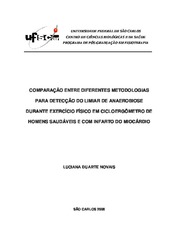Comparação entre diferentes metodologias para detecção do limiar de anaerobiose durante exercício físico em cicloergômetro de homens saudáveis e com infarto do miocárdio
Abstract
The objectives of this study were: to determine AT of healthy (HI) and coronary disease (CD) men by ventilatory visual method (gold standard) and by means of Hinkley statistical method applied to heart rate (HR), carbon dioxide output
( CO2) and surface electromyography (sEMG) root mean square (RMS) data, and to compare both methods in each studied group; to evaluate and to compare the heart rate variability (HRV) responses in resting supine and sitting positions in HI and CD groups; to compare the responses of cardiopulmonary and muscle variables between HI and CD groups at effort peak and at anaerobic threshold (AT); to correlate HRV indexes obtained in resting conditions to oxygen uptake ( O2) obtained at AT and at effort peak. Twenty middle-aged men were studied (10 HI and 10 CD), during three
protocols: I) Cardiologic and clinical evaluations; II) Resting conditions: HR and R-R intervals (R-Ri, in ms) were collected during 900s in supine and sitting positions; III) Ergoespirometric test: the protocol consisted of 1 resting min, 4 min of warm-up and 15W/min increments until physical exhaustion or reaching maximum HR predicted by age. The ventilatory and metabolic variables were collected on a breath-by-breath basis, HR was collected on a beat-to-beat basis and vastus lateralis sEMG signal was collected all over the test. For the analysis of resting conditions (PII) RMSSD
index of R-Ri (ms) was used for time domain data analysis; for frequency domain analysis, an auto-regressive model was used to obtain very low (VLF), low (LF) and high frequency (HF) bands; LF and HF bands were expressed as absolute and
normalized units and as the LF/HF ratio. No statistically significant (p>0.05) interaction was found among the different groups and studied positions. In the exercise condition (PIII) AT determination was realized by gold standard method,
identifying the loss of parallelism between O2 and CO2 responses, and by means of Hinkley statistical model applied to CO2, HR and sEMG RMS index, and the two methods were compared. The cardiopulmonary and muscles variables values at AT (gold standard) and at maximum effort were compared between the two studied groups. No significant differences were found among the different AT determination methods. In inter-groups analysis, significant differences were found in O2
(mlO2/kg/min), ventilatory equivalent for oxygen ( E/ O2) and for carbon dioxide ( E/ CO2) values at AT and at maximum effort and in O2 (ml/min) values at maximum effort. We found weak and median correlations between HRV indexes obtained in resting conditions and O2 obtained at AT and at effort peak. Although HRV is an important index of heart rate autonomic modulation evaluation, we concluded that we cannot use it to estimate aerobic power and capacity of these
subjects, due to the weak correlations. IM individuals presented lower aerobic power and capacity in comparison to SA individuals, and the statistical model studied showed to be effective for determining AT in both groups age- and diseaseindependently, which allows the safe prescription of physical activity for healthy individuals as for individuals with old myocardial infarction.
